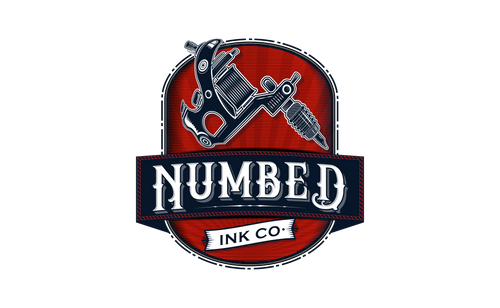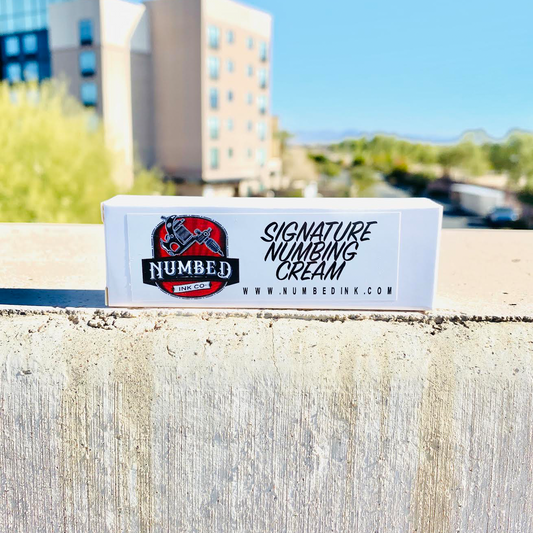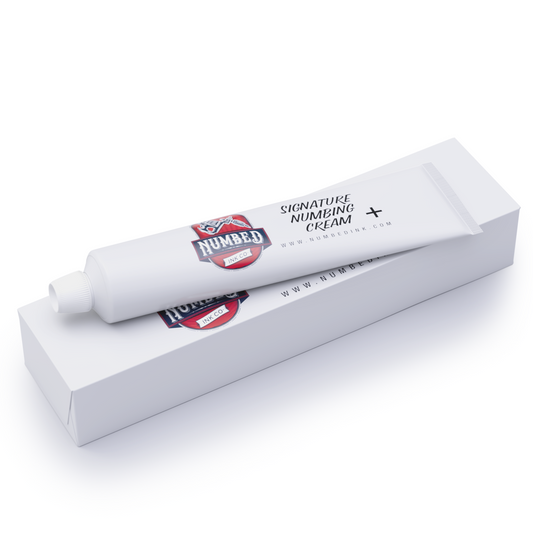Tattoos are a big commitment. From picking the design and artist to enduring hours under a painful needle. But these are just the first steps in your tattoo journey.
The bulk of your time will actually be spent healing. And how long does it take tattoos to heal? Is there any way to speed up the healing process? And what might slow it down?
If you’re stressed about your tattooed skin healing in time for your big event or you’ve already gotten it and are wondering if it’s healing properly, don’t worry. We’re gonna tell you everything you need to know about the tattoo healing process (and more).
Tattoo Healing Stages - A Complete Timeline
Let’s get straight to the point. The outer layer of your new tattoo will heal within 2-3 weeks, though the entire healing process often takes upwards of 6 months. Here’s a full timeline of what you can expect while you recover.
The First 24-48 Hours
The first 24-48 hours after a new tattoo are critical to the healing process. The area will be covered when you leave the studio – keep the bandage on for 4-6 hours. During this time, you’ll feel a burning sensation accompanied by redness and oozing. The burning sensation should subside after a day.
The redness and oozing will continue into the second day along with general inflammation. Your skin will be hot to the touch which you’ll notice if you hold your hand over the area or wear tight clothing that covers the area. You shouldn’t be wearing tight clothing after a tattoo anyways, we’ll cover that later on.
During this time, your body will ooze a pus-like substance. This is a combination of plasma and white blood cells, a healing response that keeps the area clean and promotes healthy scabbing. If you notice ink is also leaking from the area, don’t freak out. This is called “weeping” and is completely normal – it won’t affect the ink quality or cause it to fade.
There’s so much going on in the first 48 hours that it’s easy to forget about tattoo aftercare. But this is the most critical part of the healing process; what you do in this stage will dictate how the rest of the process goes. Make sure to clean the tattoo at least 3 times per day with warm water and unscented soap, gently scrubbing the area for at least 30 seconds. There are plenty of tattoo-specific soaps available but Dr. Bronner Liquid Baby Soap ($8) and Dial Liquid Hand Soap ($2) will do the trick. They’re both available on Amazon and most major retail stores.
If you’re wondering “when can I shower after a tattoo?,” you have two options. We recommend showering within the first 4-6 hours after your session, while the area is still covered with a bandage. If you opt to wait until it’s off, you can still shower in the first 24 hours – just keep the area away from scalding hot water and limit your time in the shower.
Cleaning is only part of the aftercare routine, moisturizing is the other. Hydrated skin heals better, enabling skin cells to regenerate more quickly and effectively. Just like the soap, apply non-scented lotion to the area after cleaning to help your cells heal. One thing to note is that you should wait until your skin begins to dry out before applying lotion for the first time. This generally occurs around the 24 hour mark, meaning you should apply it after the second or third cleaning session. After the first 24 hours, you should continue to moisturize twice per day for the next few weeks.
Days 3-7
Most of your pain should be gone by day 3 but plasma will continue to ooze for up to 6-7 days. If it persists past this point, contact your doctor immediately as the area is likely infected.
The area will still be red & irritated during this period and your skin will begin to peel by the end of week 1. Peeling is a healthy part of the process and indicates that your body is shedding dead skin cells and replacing them with healthy ones. But just as with a sunburn, peeling skin causes itchiness. Resist the urge to scratch the area by applying moisturizer or placing an ice pack over the area, separated by your clothes or a thin towel. The ice pack should quickly remove the urge.
If you have an immune disorder, iron deficiency, chronic dehydration, or are prone to bruising, you may experience additional bruising and redness during this time. As long as you’ve cleared your new tattoo with your doctor, this is normal.
Week 2 (days 8-14)
The first week is over. If you’ve kept your skin free from infection and continued to moisturize twice per day, you should be well on your way to a healthy & efficient healing process.
The outer layer of skin (epidermis) has begun to heal and your wounds are now sealed thanks to the oozing plasma & white blood cells. Your tattooed skin will continue to flake, peel, and itch – this is normal.
If the itching becomes unbearable or persists past 12-14 days, speak to your doctor immediately. The area is likely infected and they may recommend or even prescribe an oral antihistamine to prevent you from itching.
Weeks 3 & 4 (days 15-28)
By week three, the redness and peeling should be gone. Healthy cells have replaced dead, damaged cells and the top layer is nearly healed. Your skin may look “scaly” but again this is a normal part of the healing process.
The outer layer of skin should be fully healed by the end of week four, if not sooner. The ink may look a bit dull but it will shine through the skin once the new layer settles.
If you’ve hit this point and are wondering “‘how do I know my new tattoo is healed?,” it will be pretty obvious. The symptoms that you dealt with for the previous few weeks (itching, peeling, redness, etc.) will be gone and your skin will start looking normal again.
Months 2+
The epidermis heals within 3-4 weeks of your tattoo. But there’s still plenty going on below the surface as deeper layers continue to rebuild and adjust to the new ink. You won’t feel much discomfort (if any) after month 1 but it’s important to continue moisturizing the area 1-2x per day. With the top layer of skin fully healed, you won’t have to clean the area or avoid the sun or water. But you should still be mindful, using sunscreen and monitoring for signs of infection over the next few months.
Factors that affect the tattoo healing process
Location & body part
Tattoos in areas where your skin is constantly moving or stretching like your neck, wrist, foot, hand, and finger will take longer to heal than most. It’s usually no more than a few extra days but try to limit movement around the area as much as possible. Tattoos in sensitive areas like the face, lips, and inner thigh almost always take a bit longer to heal as well.
Size
It makes sense that larger tattoos take longer to heal – more cells must regenerate over a larger surface area. Not to mention, it’s harder to prevent a larger area from becoming infected or drying out.
Color
Colored tattoos take longer to heal, often 1-2 weeks longer than most. As an example, a black & gray chest tattoo normally heals in 3-4 weeks but a colored version of the same design will take 5-6 weeks.
This is because the artist has to move the needle across every square inch of the tattoo, meaning more damaged cells. Colored ink also has tiny pieces of metal which don’t bode well for healing.
How to speed up the tattoo healing process
The best way to speed up the tattoo healing process is by following these basic tattoo aftercare guidelines.
1. Clean & moisturize daily
Cleaning and moisturizing are the two most important elements of tattoo aftercare. If you do both of these 2-3x per day for the first 2-3 weeks after your tattoo, you’ll heal just fine. Make sure to use non-scented soaps & lotions or a tattoo-specific moisturizer.
2. Wear loose clothing
Loose clothing will reduce the amount of friction between your healing skin and fabric. Tight clothing will prevent your skin from being able to breathe and the friction will irritate and damage the ink. This means no skinny jeans or compression clothing. Loose cotton clothing will also protect the area from UV exposure, infections, and unintentional scrapes.
3. Avoid the sun and pool
Prolonged UV exposure will cause your skin to peel, potentially leading to infection. Not to mention, it will definitely fade your tattoo. As fun as pools, lakes, and oceans are, they’re not safe for your healing skin. There are millions of microbes that could infect the area before it’s even begun to heal. Stay away from the sun and water for at least 3 weeks.
Frequently Asked Questions
How do you know your tattoo is healed?
If you’ve recently gotten a new tattoo and your healing process doesn’t match this timeline exactly, don’t stress yourself out. Everyone heals at different rates. But if you notice any of the following symptoms sticking around longer than they should, you should speak with your doctor (not your artist) right away:
- Prolonged redness - should subside within 4-5 days.
- Oozing plasma, pus, and/or ink - lasts 1-3 days
- Swollen or puffy skin - lasts 1-3 days
- Itching - lasts 1-2 weeks. If it’s worse than general discomfort or accompanied by hives, bumps, or blisters, visit your doctor.
- Scarring - should not scar
Why is my tattoo healing badly?
If your tattoo isn’t healing properly, it’s likely because of one of these reasons:
- Infection
- Not enough moisturizer or using a scented one that contains alcohol
- Dehydration
- Scratching, itching, or picking at scabs
- Prolonged UV or sun exposure
- Infected from water exposure
How long do small tattoos take to heal?
Small tattoos heal faster than medium to large-sized tattoos, usually closer to 2 weeks.
How long do finger tattoos take to heal?
Finger tattoos can take up to 6 weeks to heal, longer than other tattoos because the skin is constantly wrinkling and it’s hard to keep the area clean & moisturized.
How should my tattoo look after 3 days? After a week?
After three days, your tattoo may still be tender, red, and swollen, and it might start to scab or form a protective layer. It's normal for the tattoo to feel itchy and appear somewhat dull or faded during this stage of the healing process.
After a week, the redness and swelling should have subsided. At this point, the skin should begin to scab and flake. The itchiness may persist, but the tattoo should gradually appear more vibrant as it continues to heal.
What should you not do after a tattoo?
You should not exercise or visit the sauna, spend time in the sun, go swimming, or scratch the area directly after getting a tattoo.



